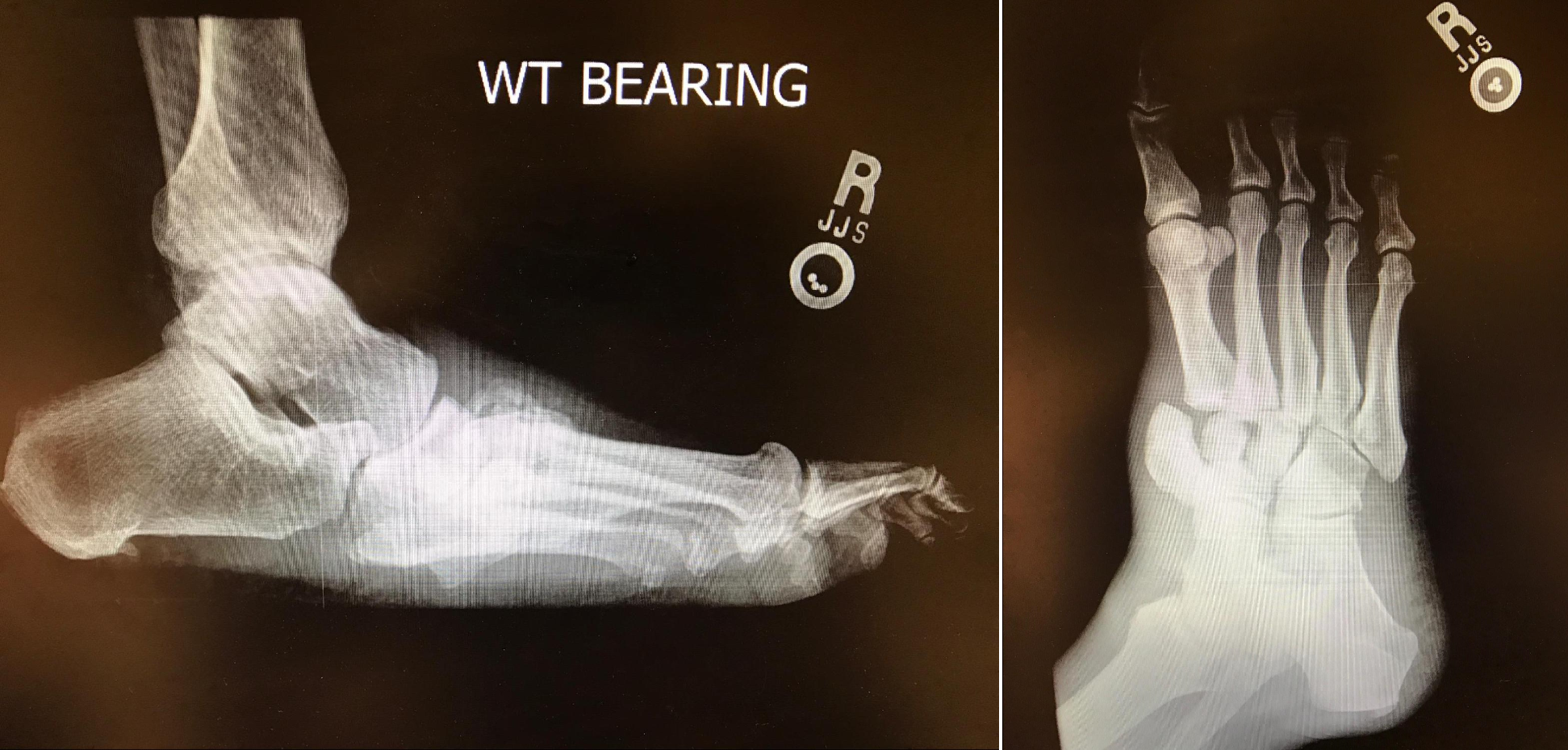[1]
Kampen WU,Westphal F,Van den Wyngaert T,Strobel K,Kuwert T,Van der Bruggen W,Gnanasegaran G,Jens JH,Paycha F, SPECT/CT in Postoperative Foot and Ankle Pain. Seminars in nuclear medicine. 2018 Sep;
[PubMed PMID: 30193651]
[2]
Figueiredo A,Ferreira R,Alegre C,Fonseca F, Charcot osteoarthropathy of the knee secondary to neurosyphilis: a rare condition managed by a challenging arthrodesis. BMJ case reports. 2018 Aug 20;
[PubMed PMID: 30131415]
Level 3 (low-level) evidence
[3]
Dixon J,Coulter J,Garrett M,Cutfield R, A retrospective audit of the characteristics and treatment outcomes in patients with diabetes-related charcot neuropathic osteoarthropathy. The New Zealand medical journal. 2017 Dec 15;
[PubMed PMID: 29240741]
Level 2 (mid-level) evidence
[4]
Zhao HM,Diao JY,Liang XJ,Zhang F,Hao DJ, Pathogenesis and potential relative risk factors of diabetic neuropathic osteoarthropathy. Journal of orthopaedic surgery and research. 2017 Oct 2;
[PubMed PMID: 28969714]
[5]
Sinacore DR,Bohnert KL,Smith KE,Hastings MK,Commean PK,Gutekunst DJ,Johnson JE,Prior FW, Persistent inflammation with pedal osteolysis 1year after Charcot neuropathic osteoarthropathy. Journal of diabetes and its complications. 2017 Jun;
[PubMed PMID: 28254346]
[7]
Miller RJ, Neuropathic Minimally Invasive Surgeries (NEMESIS):: Percutaneous Diabetic Foot Surgery and Reconstruction. Foot and ankle clinics. 2016 Sep;
[PubMed PMID: 27524708]
[8]
McInnes AD, Diabetic foot disease in the United Kingdom: about time to put feet first. Journal of foot and ankle research. 2012 Oct 11
[PubMed PMID: 23050905]
[9]
Kaynak G,Birsel O,Güven MF,Oğüt T, An overview of the Charcot foot pathophysiology. Diabetic foot & ankle. 2013
[PubMed PMID: 23919113]
Level 3 (low-level) evidence
[10]
McEwen LN,Ylitalo KR,Herman WH,Wrobel JS, Prevalence and risk factors for diabetes-related foot complications in Translating Research Into Action for Diabetes (TRIAD). Journal of diabetes and its complications. 2013 Nov-Dec
[PubMed PMID: 24035357]
[11]
Metabolite sensitivity in the methaqualone radioimmunoassay., Keppler BR,Manders WW,Dominguez AM,, Journal of forensic sciences, 1977 Jan
[PubMed PMID: 9989846]
[12]
A five-year study of mortality in a busy ski population., Weston JT,Moore SM,Rich TH,, Journal of forensic sciences, 1977 Jan
[PubMed PMID: 31753572]
[13]
Płaza M,Nowakowska-Płaza A,Walentowska-Janowicz M,Chojnowski M,Sudoł-Szopińska I, Charcot arthropathy in ultrasound examination - a case report. Journal of ultrasonography. 2016 Jun;
[PubMed PMID: 27446605]
Level 3 (low-level) evidence
[14]
Fosbøl M,Reving S,Petersen EH,Rossing P,Lajer M,Zerahn B, Three-phase bone scintigraphy for diagnosis of Charcot neuropathic osteoarthropathy in the diabetic foot - does quantitative data improve diagnostic value? Clinical physiology and functional imaging. 2017 Jan;
[PubMed PMID: 26147681]
[15]
Mautone M,Naidoo P, What the radiologist needs to know about Charcot foot. Journal of medical imaging and radiation oncology. 2015 Aug;
[PubMed PMID: 26041322]
[17]
Rosenbaum AJ,DiPreta JA, Classifications in brief: Eichenholtz classification of Charcot arthropathy. Clinical orthopaedics and related research. 2015 Mar
[PubMed PMID: 25413713]
[18]
Rosskopf AB,Loupatatzis C,Pfirrmann CWA,Böni T,Berli MC, The Charcot foot: a pictorial review. Insights into imaging. 2019 Aug 5
[PubMed PMID: 31385060]
[19]
The pathology of self-mutilation and destructive acts: a forensic study and review., Eckert WG,, Journal of forensic sciences, 1977 Jan
[PubMed PMID: 17054880]
[20]
Wukich DK,Crim BE,Frykberg RG,Rosario BL, Neuropathy and poorly controlled diabetes increase the rate of surgical site infection after foot and ankle surgery. The Journal of bone and joint surgery. American volume. 2014 May 21
[PubMed PMID: 24875024]
[22]
Ertugrul BM,Lipsky BA,Savk O, Osteomyelitis or Charcot neuro-osteoarthropathy? Differentiating these disorders in diabetic patients with a foot problem. Diabetic foot & ankle. 2013 Nov 5
[PubMed PMID: 24205433]
[23]
Simultaneous determination of cocaine and benzoyl ecgonine in urine by gas chromatography with on-column alkylation., Jain NC,Chinn DM,Budd RD,Sneath TS,Leung WJ,, Journal of forensic sciences, 1977 Jan
[PubMed PMID: 16969256]
[24]
Jansen RB,Jørgensen B,Holstein PE,Møller KK,Svendsen OL, Mortality and complications after treatment of acute diabetic Charcot foot. Journal of diabetes and its complications. 2018 Dec
[PubMed PMID: 30301593]
[25]
The absorption of arsenic into single human head hairs., Maes D,Pate BD,, Journal of forensic sciences, 1977 Jan
[PubMed PMID: 9171250]
[26]
Game FL,Catlow R,Jones GR,Edmonds ME,Jude EB,Rayman G,Jeffcoate WJ, Audit of acute Charcot's disease in the UK: the CDUK study. Diabetologia. 2012 Jan
[PubMed PMID: 22065087]
[27]
Jupiter DC,Thorud JC,Buckley CJ,Shibuya N, The impact of foot ulceration and amputation on mortality in diabetic patients. I: From ulceration to death, a systematic review. International wound journal. 2016 Oct
[PubMed PMID: 25601358]
Level 1 (high-level) evidence
[28]
Effect of hemoperfusion with coated and uncoated charcoal on human blood in vitro., Ott NT,Kohnle W,Scheck R,Konstantin P,Franz HE,, Journal of dialysis, 1979
[PubMed PMID: 26898398]
[29]
Aulivola B,Hile CN,Hamdan AD,Sheahan MG,Veraldi JR,Skillman JJ,Campbell DR,Scovell SD,LoGerfo FW,Pomposelli FB Jr, Major lower extremity amputation: outcome of a modern series. Archives of surgery (Chicago, Ill. : 1960). 2004 Apr
[PubMed PMID: 15078707]

